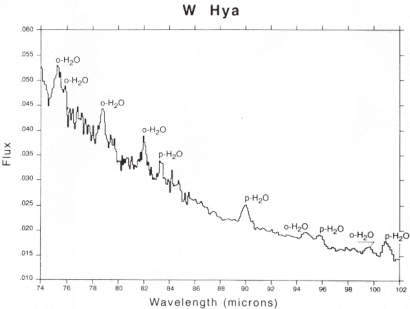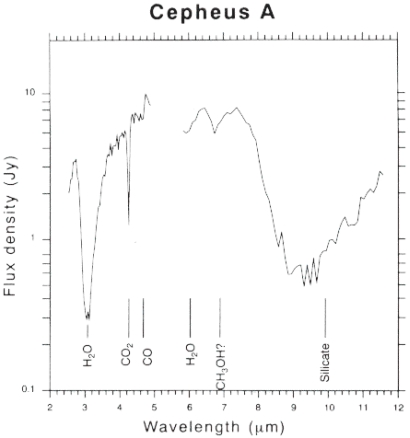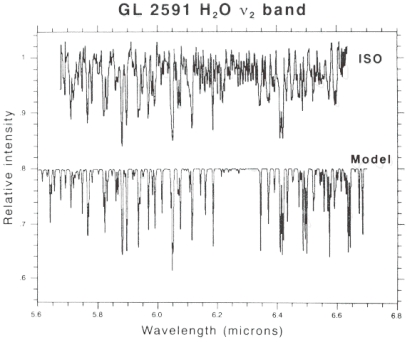INFO 14-1996: Cosmic water traced by Europe's space telescope ISO
12 June 1996
The water that we drink and which fills the world's oceans had its origin among the stars. Astronomers are enthralled by results from the European Space Agency's Infrared Space Observatory, ISO, which reveal the chemistry of our Galaxy in unprecedented detail. Surprisingly conspicuous in the neighbourhood of stars at the end of their lives is water vapour made by the combination of primordial hydrogen with oxygen atoms newly manufactured by the stars themselves. Water then reappears during the formation of new stars and planets from the interstellar medium. This happened at the origin of tbe Solar System, and incidentally supplied the water which accounts for more than half of a human being's body weight.In retracing this history, ISO also observes water in the form of ice in cooler regions around the stars, and in the dust surrounding young stars, from which planets could evolve. Comets represent an intermediate stage in planet-building, and they contain much water ice. According to one hypothesis the newly formed Earth received some of its water directly from impacting comets.
 |
|
Long Wavelength Spectrometer: part of the spectrum of the dying star W Hydrae, showing water-vapour lines. Notations o-H2O and p-H2O refer to alternative orientations of the hydrogen nuclei. |
Water vapour in the Earth's atmosphere has prevented telescopes on the ground from detecting the water vapour among the stars, except in very unusual circumstances. ISO orbiting in space escapes the impediment of the atmosphere. Excellent onboard instruments register the characteristic infrared signatures of water vapour, water ice and many other materials.
 |
|
Photometer ISOPHOT-S: Short wavelength Spectrum of the star-forming region Cepheus A showing the presence of various materials - water ice, silicates and simple carbon compounds. |
When ISO scrutinizes selected objects, it detects emissions or absorptions of infrared rays at particular wavelengths, or "lines" in a spectrum, which reveal the presence of identifiable atoms, molecules and solids. The Short Wavelength Specrometer and the Long Wavelength Spectrometer provide detailed chemical diagnoses, and the photometer ISOPHOT and camera ISOCAM also have important spectroscopic capabilities.
Examples of water detection were among many topics reviewed at the First ISO Science Workshop held at ESA's Research and Technology Centre (ESTEC) in Noordwijk, the Netherlands (29-31 May) when 300 astronomers from Europe, the USA and Japan gathered to assess results from ISO since its launch on 17 November 1995. The Long Wavelength Spectrometer has made remarkable observations of water-vapour lines in the vicinity of dying stars and in star-forming regions. So has the Short Wavelength Spectrometer, which also detects water ice. The photometer ISOPHOT has registered water ice in a large number of objects.
Although fascinated by the natural history of water in the cosmos, astronomers have more technical reasons for welcoming ISO's observations. They can use thc details in a spectrum to reduce the abundance of water and its physical circumstances. In the case of the newly forming star GL 2591 for example, frozen water has vaporized in the warmth of the star and risen to a temperature of about 30 degrces Celsius. The amount of water vapour, roughly 10 parts per million compared with hydrogen, is very high by cosmic standards.
 |
|
Short Wavelength Spectrometer: part of the spectrum of a newly formed massive star showing water-vapour lines. The lower plot shows the theoretical expectations for water vapour at 300 K. |
"Its remarkable abundance tells us that water plays an important part in the birth of stars," says Ewine van Dishoeck of Leiden Observatory, whose team of astronomers from the Netherlands and Sweden has used ISO's Short Wavelength Spectrometer in this work. "Stars form by the collapse of a cloud of gas and dust, but a build-up of heat inside the cloud makes the work of gravity harder, when it tries to compress the cloud. By radiating strongly in the infrared, water enables the cloud to shed heat very efficiently. This cooling function of water facilitates star formation. So here ISO gives us a new clue in astrophysics."
An inventory of interstellar ice
The spaces between the stars are very cold, so vapours like water condense and freeze on the surface of available grains, in the manner of frost in winter. They form part of the interstellar dust that darkens the visible sky and which ISO is thoroughly analysing for the first time. The Short Wavelength Spectrometer sees water ice in many settings, for example in NGC 7538, a cloud surrounding a newly forming star. Before ISO, ground-based telescopes had found frozen carbon monoxide and methanol (methyl alcohol) in interstellar space, as well as water ice. ISO observes all these ices much more clearly. It has also seen carbon dioxide ice and methane ice, which are undetectable from the ground. French astronomers have even distinguished ice containing heavy carbon-13, in the ISO data.
The amounts of carbon dioxide and methane detected by ISO are surprising, and ices now account for a larger proportion of the carbon compounds drifting in space. Carbon dioxide ice ranks second to water ice in the vicinity of NGC 7538. Astronomers can start making a complete inventory of the frozen volatile materials in interstellar space and compare them with those found in the Solar System.
"ISO gives us spectra of the kind we dust people used to dream of," says Doug Whittet of the Rensselaer Polytechnic Institute in Troy, New York, who leads a US-Dutch team using the Short Wavelength Spectrometer in this study, "Our detection of carbon dioxide and methane in interstellar ices has implications for understanding the behaviour of comets, as well as the origin and evolution of life on Earth."
Sand and soot among the stars
Other components of the dust identified by ISO are mineral grains and large molecules built mainly of carbon and hydrogen, often called hydrocarbons for simplicity's sake. Here too there is a direct connection with the history of the Solar System and the Earth, because similar minerals and hydrocarbons turn up in meteorites and in comets, as analysed for example by ESA's Giotto mission to Halley's Comet in 1986.
Silicate minerals, familiar as sand on the seashore. are the principal constituents of the solid Earth. Ground-based infrared telescopes have glimpsed the characteristic signatures of silicate grains in various interslellar settings, but again ISO has a better view. It has observed silicates and other minerals both in the vicinity of dead stars like the planetary nebula NGC 6302, and in disks of dust around young stars where new planets may be forming.
In such protoplanetary disks, astronomers using ISO's Short Wavelength Spectrometer have confirmed the existence of a special form of silicon oxide. It was previously found in comets, and seen in interstellar space only with difficulty and uncertainty by ground-based telescopes. Other silicon oxides are widespread in the Galaxy in non-crystalline (amorphous) form. The special silicon oxide, which may be crystals, is possibly a symptom of planet-making in progress.
Thanks especially to carbon compounds, the Universe is capable of supporting life. A widespread infrared emission at around 12 microns, first noted in 1983 by the IRAS sate11ite in the Milky Way and in other galaxies, turns out to be due to hydrocarbons gathered in wispy clouds. In interstellar space, complex hydrocarbons make tarry grains similar to the soot from car exhausts or coal fires. ISO's instruments, identifying these hydrocarbons by their characteristic infrared wavelengths, find them almost everywhere they look, except close to stars which tend to decompose the hydrocarbons. Teams are using the ISOPHOT and ISOCAM instruments to survey the hydrocarbons in dozens of locations in the Galaxy. The hydrocarbons appear most conspicuous at the outer surfaces of dense clouds of gas and dust, and should give clues to physical conditions prevailing there.
Shortly before ISO's launch, amateur astronomers reported that the star called R Coronae Borealis was fading from view. This elderly star is normally quite easy to see with binoculars, but intermittently it puffs off clouds of dust that almost hide it from view. Professional astronomers do not have the time to monitor irregularly variable stars, and rely on amateurs to alert them to such events like that in R Coronae Borealis. A few months later when the star could be seen only with powerful telescopes, ISO obtained an infrared spectrum of the star in just one minute, using the high-speed spectroscopic facility of the photometer ISOPHOT.
"We caught this star smoking," says Helen Walker of the Rutherford Appleton Laboratory in England, who was in charge of the observation, "The amateurs saw the star fade from view in visible light in October, but it remained bright in the infrared. The telltale wavelengths revealed sooty carbon compounds newly formed in the star's vicinity. Without ISO we could not hope to analyse such a striking event."
Complexity and inspiration
ISO's camera ISOCAM has obtained impressive images of interstellar dust in many parts of the Galaxy. ISOCAM often uses its spectral capabilities to decompose tbe dusty emissions by wavelength, and so determine their origins. One of the places where ISOCAM has detected extensive regions of hydrocarbons is at the outer edge of the Rho Ophiuchi dark cloud. At 500 light-years, this is also the nearest scene of recent star formation. Spectacular images from ISOCAM show many young stars unseen by visible light, and remarkable filamentary structures in their envelope of dust.
ISO is providing astronomers with more details about the interstellar medium than they can fully understand so far. Not only do chemical mysteries lurk in spectra still being analysed, but some of the spatial features of the Galaxy imaged by ISO leave astronomers scratching their heads. Co-existing cold and hot regions make complicated patterns, which were preeviously thought of only as lukewarm averages.
"The Universe is a very complex place," warns Martin Harwit, a pioneer of infrared astronomy, "But ISO is defining its overall contents, assessing the energy budgets of our Galaxy and others, and teaching us a lot about the demography of old and young stars. For me, the results of ISO so far are inspirational."
